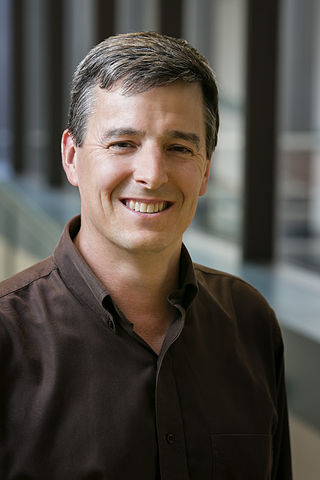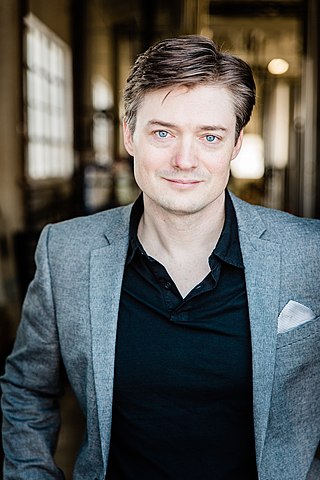Energy harvesting is the process by which energy is derived from external sources, then stored for use by small, wireless autonomous devices, like those used in wearable electronics, condition monitoring, and wireless sensor networks.
An active structure is a mechanical structure with the ability to alter its configuration, form or properties in response to changes in the environment.

An ultrasonic motor is a type of piezoelectric motor powered by the ultrasonic vibration of a component, the stator, placed against another component, the rotor or slider depending on the scheme of operation. Ultrasonic motors differ from other piezoelectric motors in several ways, though both typically use some form of piezoelectric material, most often lead zirconate titanate and occasionally lithium niobate or other single-crystal materials. The most obvious difference is the use of resonance to amplify the vibration of the stator in contact with the rotor in ultrasonic motors. Ultrasonic motors also offer arbitrarily large rotation or sliding distances, while piezoelectric actuators are limited by the static strain that may be induced in the piezoelectric element.

John A. Rogers is a physical chemist and a materials scientist. He is currently the Louis Simpson and Kimberly Querrey Professor of Materials Science and Engineering, Biomedical Engineering, and Neurological Surgery at Northwestern University.

Dava J. Newman is an American aerospace engineer. She is the director of the MIT Media Lab and a former deputy administrator of NASA. Newman is the Apollo Program Professor of Aeronautics and Astronautics and Engineering Systems at the Massachusetts Institute of Technology. She has been a faculty member in the department of Aeronautics and Astronautics and MIT's School of Engineering since 1993.
CSA was a division of Cambridge Information Group and provider of online databases, based in Bethesda, Maryland, before merging with ProQuest of Ann Arbor, Michigan, in 2007. CSA hosted databases of abstracts and developed taxonomic indexing of scholarly articles. These databases were hosted on the CSA Illumina platform and were available alongside add-on products like CSA Illustrata. The company produced numerous bibliographic databases in different fields of the arts and humanities, natural and social sciences, and technology. Thus, coverage included materials science, environmental sciences and pollution management, biological sciences, aquatic sciences and fisheries, biotechnology, engineering, computer science, sociology, linguistics, and other areas.

The A. James Clark School of Engineering is the engineering college of the University of Maryland, College Park. The school consists of fourteen buildings on the College Park campus that cover over 750,000 sq ft (70,000 m2). The school is near Washington, D.C. and Baltimore, as well as several technology-driven institutions.

Mercedes Reaves is a Puerto Rican research engineer and scientist. She is responsible for the design of a viable full-scale solar sail and the development and testing of a scale model solar sail at NASA Langley Research Center in Virginia.
Satya Atluri is an American engineer, educator, researcher and scientist in aerospace engineering, mechanical engineering and computational sciences, who is currently a Distinguished Professor Emeritus of Aerospace Engineering at the University of California, Irvine. Since 1966, he made fundamental contributions to the development of finite element methods, boundary element methods, Meshless Local Petrov-Galerkin (MLPG) methods, Fragile Points Methods (FPM), Local Variational Iteration Methods, for general problems of engineering, solid mechanics, fluid dynamics, heat transfer, flexoelectricity, ferromagnetics, gradient and nonlocal theories, nonlinear dynamics, shell theories, micromechanics of materials, structural integrity and damage tolerance, Orbital mechanics, Astrodynamics, digital Twins of Aerospace Systems, etc.
The National Institute of Aerospace (NIA) is a non-profit research and graduate education institute headquartered in Hampton, Virginia, near NASA's Langley Research Center.

Chih-Kung Lee is a Taiwanese mechanical engineer. He received his B.S. degree in civil engineering from National Taiwan University and then obtained his M.S. and Ph.D. degrees from Cornell University, majoring in theoretical & applied mechanics, with a minor in physics. He is known as the inventor of modal sensors and actuators. In the past, he has been an advisor to the Ministry of Education, Ministry of Economic Affairs and various other governmental agencies, as well as the director general of engineering & applied sciences at Taiwan's National Science Council (NSC). Currently, he is the chairman of Industrial Technology Research Institute (ITRI) and Institute for Information Industry (III). He is also a distinguished professor of the Graduate Institute of Electronics Engineering, the Institute of Applied Mechanics (IAM) and the Dept. of Engineering Science & Ocean Engineering at National Taiwan University.
The University at Buffalo School of Engineering and Applied Sciences, or UB Engineering, is the largest public engineering school in the state of New York and is home to eight departments. Established in 1946, UB Engineering is ranked 59th by U.S. News & World Report and has an annual research expenditure of $72 million.

Nils Otto Myklestad was an American mechanical engineer and engineering professor. An authority on mechanical vibration, he was employed by a number of important US engineering firms and served on the faculty of several major engineering universities. Myklestad made significant contributions to both engineering practice and engineering education, publishing a number of widely influential technical journal papers and textbooks. He also was granted five US patents during his career.

Kenji Uchino is an American electronics engineer, physicist, academic, inventor and industry executive. He is currently a Professor of Electrical Engineering at Pennsylvania State University, where he also directs the International Center for Actuators and Transducers at Materials Research Institute. He is the former Associate Director at The US Office of Naval Research – Global Tokyo Office.

Leroy Stevenson (Skipp) Fletcher is an American mechanical and aerospace engineer, and college dean, who served as the 104th president of the American Society of Mechanical Engineers in 1985–86, and was recipient of the 2002 ASME Medal.
Daniel J. Inman is an American mechanical engineer, Kelly Johnson Collegiate Professor and former Chair of the Department of Aerospace Engineering at the University of Michigan.

Andrew Alan Rader is a Canadian author and aerospace engineer. Rader was the Season 2 winner of the Discovery series, Canada's Greatest Know-It-All. Originally from Ottawa, Canada, Rader now works for SpaceX as a Mission Manager in Los Angeles.
Nazanin Bassiri-Gharb is a mechanical engineer in the field of micro and nano engineering and mechanics of materials. She is the Harris Saunders, Jr. Chair and Professor in the George W. Woodruff School of Mechanical Engineering at the Georgia Institute of Technology in Atlanta, Georgia. Bassiri-Gharb leads the Smart Materials, Advanced Research and Technology (SMART) Laboratory at Georgia Tech. Her research seeks to characterize and optimize the optical and electric response of interferometric modulator (IMOD) displays. She also investigates novel materials to improve reliability and processing of IMOD.
Diann Erbschloe Brei is an American mechanical engineer whose research focuses on smart materials and piezoelectric actuators. She is a professor of mechanical engineering at the University of Michigan.
Alison B. Flatau is an American aerospace engineer whose research involves smart materials and magnetostriction, changes in the physical shape of materials under magnetic fields, and in the application of nanowires built from these materials in controlling the flight of micro air vehicles. She is a professor and department chair of the Department of Aerospace Engineering in the A. James Clark School of Engineering at the University of Maryland, College Park.









